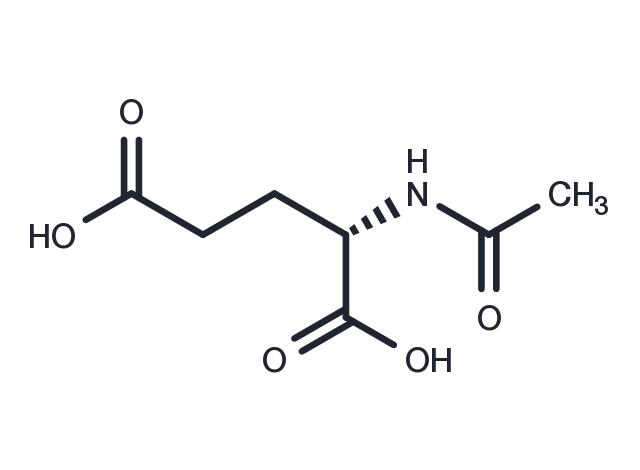Powder: -20°C for 3 years | In solvent: -80°C for 1 year


N-Acetyl-L-glutamic acid (Ac-L-Glu-OH) (NAcGlu) is an acetylated amino acid. NAcGlu is biosynthesized from glutamic acid and acetyl-CoA by the enzyme N-acetyl glutamate synthase (NAGS). NAcGlu activates carbamoyl phosphate synthetase in the urea cycle. A deficiency in N-acetyl glutamate synthase or a genetic mutation in the gene coding for the enzyme will lead to urea cycle failure in which ammonia is not converted to urea, but rather accumulated in the blood leading to the condition called Type I hyperammonemia.

| Pack Size | Availability | Price/USD | Quantity |
|---|---|---|---|
| 500 mg | In stock | $ 41.00 | |
| 1 mL * 10 mM (in DMSO) | In stock | $ 45.00 |


| Description | N-Acetyl-L-glutamic acid (Ac-L-Glu-OH) (NAcGlu) is an acetylated amino acid. NAcGlu is biosynthesized from glutamic acid and acetyl-CoA by the enzyme N-acetyl glutamate synthase (NAGS). NAcGlu activates carbamoyl phosphate synthetase in the urea cycle. A deficiency in N-acetyl glutamate synthase or a genetic mutation in the gene coding for the enzyme will lead to urea cycle failure in which ammonia is not converted to urea, but rather accumulated in the blood leading to the condition called Type I hyperammonemia. |
| Synonyms | Ac-L-Glu-OH, N-Acetylglutamic acid |
| Molecular Weight | 189.17 |
| Formula | C7H11NO5 |
| CAS No. | 1188-37-0 |
Powder: -20°C for 3 years | In solvent: -80°C for 1 year
DMSO: 200 mM
You can also refer to dose conversion for different animals. More
bottom
Please see Inhibitor Handling Instructions for more frequently ask questions. Topics include: how to prepare stock solutions, how to store products, and cautions on cell-based assays & animal experiments, etc.
N-Acetyl-L-glutamic acid 1188-37-0 Metabolism Others Endogenous Metabolite Inhibitor Ac-L-Glu-OH NAcetylLglutamic acid N Acetyl L glutamic acid inhibit N-Acetylglutamic acid inhibitor
